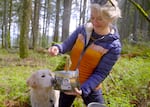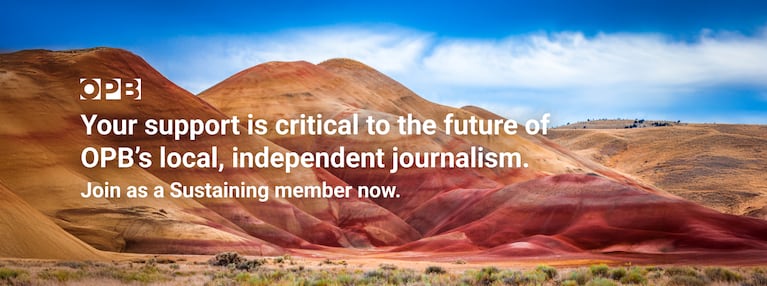In the Pacific Northwest, farmers markets show off the bounties of the region, like strawberries and mushrooms. But food, especially produce, only stays fresh for so long.
Preservation is at the heart of any pantry and one method for making food last is skyrocketing in popularity: freeze drying.
And if you’ve ever eaten a freeze-dried meal, chances are it came from Oregon.
Welcome to Mountain House
Freeze drying is a multi-billion-dollar global industry, and the biggest player in North America is in Albany, Oregon.
In the 1960s, Oregon Freeze Dry started by making freeze-dried fruits for cereals and MREs, short for “meals ready to eat,” for the U.S. military. Just add water and you have a meal, no matter where you are.

In this provided photo from 1966, American soldiers eat freeze-dried meals made by Oregon Freeze Dry.
Courtesy Oregon Freeze Dry
After the Vietnam War, leftover MREs at sporting good stores flew off the shelves. The masses wanted freeze-dried meals so they could eat them out in nature.
So as a parent company, Oregon Freeze Dry launched the Mountain House brand to meet recreational demand.
And those products advertise a 30-year taste guarantee.
“Mountain House I think is known in industry as the Coca-Cola of the freeze-dried outdoor meals,” said Drew Huebsch, director of research and development at Oregon Freeze Dry.
“We get to be part of people’s adventure,” said Huebsch. “If you think about our products, it’s been as high as people have gone and as low as people have gone, so on submarines and in space stations. It’s a pretty cool technology to be able to support all of that.”
The science of shelf stability
So what exactly is freeze drying?
It’s a choreography of time, temperature and pressure.
“We work in freezers, we work in dry side rooms… We have to hit critical control points for food safety,” said Chad Lewis, plant manager at Oregon Freeze Dry. “One day we’ll work in a -35 F environment to the next day we’re pulling 150 F cart [of food] into the room.”

Staff pour a bucket of sour cream into a large drum at the start of a batch of beef stroganoff for freeze drying in Albany, Ore., April 10, 2025. When done, the food will be packaged as Mountain House meal pouches.
Stephani Gordon / OPB
While modern freeze drying took off in the 20th century, the technique is much older as one of the several ways to store food.
Freeze drying, also known as lyophilization, can be traced back to the Incas. They used cold, high altitude air in the Andes Mountains to freeze then dry foods like potatoes.
Whether on a mountain top or in a machine, freezing temperatures turn water in food into ice crystals. In freeze drying, lowering the air pressure forces the crystals to turn directly to vapor — the melting stage is skipped.
The ice instead sublimates, leaving the structure, nutrition and flavor of the food intact.
The result is food that can remain safe to eat for years.
As freeze-drying machines become more accessible, hobbyists and small batch producers are trying their hand at the science.
Oregon entrepreneurs are experimenting
While many have long known about astronaut ice cream, freeze-dried candies and snacks have recently exploded in popularity. The Food Network named such grab-and-go freeze-dried items as a top food trend for 2025.
Ryan and Charlotte Alston of Redmond, Oregon, saw the market potential.
After being licensed by the U.S. Department of Agriculture early last year, they started Glacier Gourmet with the idea of making snacks for their young daughters and other families seeking options.
“We really want to focus on the lifestyle foods and things that are everyday abundant in your life that can be freeze dried,” Ryan Alston said.
Like his favorite: Oregon strawberries.

Ryan Alston, co-owner of freeze-drying company Glacier Gourmet, loads a tray of strawberries into a freeze dryer in Redmond, Ore., April 5, 2025.
Stephani Gordon / OPB
“A lot of the flavor is more pronounced [in a freeze-dried strawberry]. A lot of the water in [the berry] dilutes some of the flavor, which isn’t a bad thing,” Ryan Alston said. “But when you dehydrate ‘em and freeze dry ‘em, all of the sugars and the flavor just is more readily available for your tongue to taste. It’s pretty cool.”
Currently, Glacier Gourmet makes nearly 90 freeze-dried products.
Another Oregonian putting a twist on freeze-dried food is Sara Willis, owner of Eugene-based Luxefly Basecamp.
She gained interest in freeze drying when she found a renewed love in the outdoors a few years ago.
Willis recalled a conversation she overheard on Mount Hood that resonated with her fledgling business.
“There were these guys who were coming off the trail part that’s on the PCT right there, and they were like, ‘We just want a cheeseburger.’ And I was like, ‘yeah, when I hike, I just want a cheeseburger too.’ So I went home and I was like, ‘how do I make a cheeseburger in a bag?’”

Sara Willis, chef and owner of Luxefly Basecamp, prepares a freeze-dried meal in a forest in Eugene, Ore., with her dog Simba by her side, April 3, 2025.
Stephani Gordon / OPB
After decades working in restaurants, catering and for private clients, Willis translates her chef experience into her freeze-dried meal pouches.
“The shelf stableness is the best because you’re not throwing things away, you’re not worrying about dates,” Willis said. “I enjoy freeze drying far more than fine dining.”
Freeze-dried food can be fun on trail. It’s also a lifeline for when times get tough.
Sustenance to survive
While military soldiers remain a core market for freeze-dried food, disasters and anxiety also fuel civilian purchases.
“When someone is in distress, they need something quick and easy they can rely on,” said Lewis, the Oregon Freeze Dry plant manager. “Many different groups are going to consume our products in a survival situation. That is something that I take a lot of pride in is making sure that whatever we produce. I want to make sure that it’s safe for whoever is consuming it at that time.”
At the onset of the COVID-19 pandemic in early 2020, there was a freeze-dried food purchasing frenzy.
According to Outside Magazine, from Feb. 19–26, 2020, the Mountain House website experienced a 208.6% increase in transactions compared to the week before.
“It was impossible to keep up with the demand,” Lewis said of the pandemic. “We were producing night and day, bringing in as many people as we [could], maxing out our capacity.”

Employees work inside the hallway of freeze-drying chambers at a production plant at Oregon Freeze Dry's Albany headquarters on April 10, 2025. The food made in the chambers will became Mountain House products.
Stephani Gordon / OPB
Mountain House saw huge sales in 2020, though it wasn’t totally unprecedented. The business sees upticks at times when people feel anxious about the world.
“It’s kind of a scary thought — our business booms when people are in a catastrophic moment," Lewis said. “Anytime people start to feel uneasy, we will see a spike in sales and we can associate that with world conflict, elections.”
Willis sees disaster preparedness as a driver of Luxefly Basecamp business as well.
“Preppers used to be a fringe element. You’d call somebody like a prepper as they’re a weirdo or something, right? You’re prepared, what are you doing? You have a bomb shelter full of stuff,” Willis said. “But at this point, I think everybody’s a prepper. You want to have some water and some food, and it’s actually being smart to have those things available to you.”
Willis points to a natural disaster that has become all too familiar in Oregon: record-breaking wildfire seasons.
“For the Oregon fires, people who are fighting fires up here, there’s the hot shots where you can’t get the food trucks up there and they don’t have much to work with. If you just have a kettle of hot water and one of these meals, they can eat.”
Related: Recipe for disaster: Oregon Coast group puts a twist on emergency food preparedness

A Mountain House freeze-dried prepared meal, at the Oregon Freeze Dry headquarters in Albany, Ore., April 10, 2025.
Stephani Gordon / OPB
A frontier beyond food
Freeze drying can be bigger than food.
In 2022, Oregon Freeze Dry opened its OFD Life Sciences leg with a $7.5 million biopharmaceutical facility. The move was 14 years in the making, after the company began a project with the Defense Advanced Research Projects Agency to stabilize blood platelets.
The Alstons of Glacier Gourmet learned of opportunities abound as they launched careers in freeze drying.
“Flowers, plants and wedding bouquets, slabs of wood, document preservation,” Ryan Alston listed off. “There’s so many avenues and the more creative you get, the further down the rabbit hole you go, you always want to try something else out.”
“I’m always on the lookout for fun, new stuff to freeze dry no matter what it is,” Charlotte Alston said. “It’s one of the funniest things that I’ve ever done in my life. There’s no stopping.”
This story was written, reported and digitally produced by Meagan Cuthill and edited by MacGregor Campbell, with photos by Stephani Gordon and visual editing by Kristyna Wentz-Graff.

